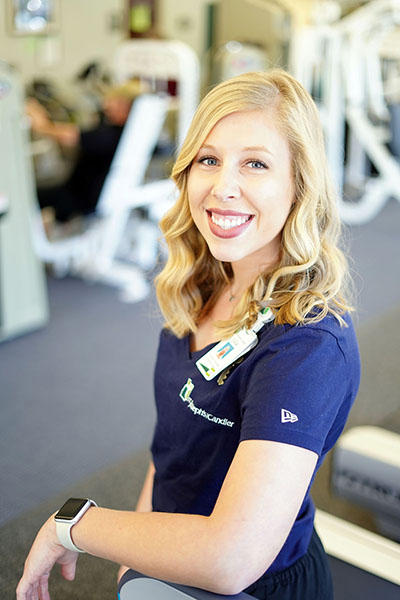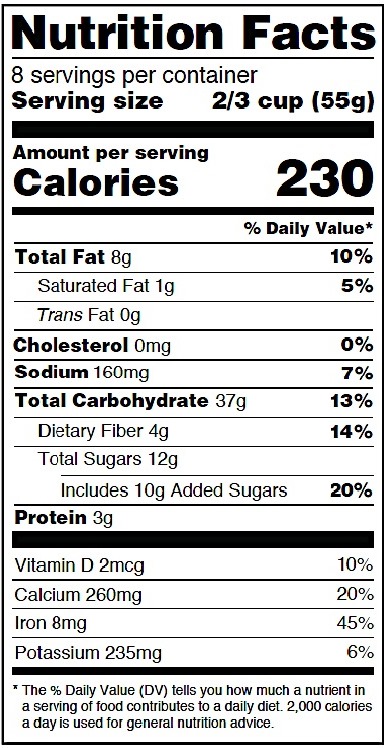Here’s why you shouldn’t always trust the front of the food package you buy
Nutrition
St. Joseph’s/Candler clinical dietitian explains the aspects of a Nutrition Facts label
Your diet is fundamental for maintaining a healthy lifestyle or controlling certain conditions such as diabetes or high blood pressure. Therefore, it is important to pay attention to the foods we eat. You can do that by reading labels and understanding what you are truly consuming.
Among the most important things to look for on food packages are food claims, serving size and ingredients.
Food claims, such as low-fat or fat-free, on the front don’t always match expectations you might find on the back. 
“A lot of times if you are getting a fat-free item or sometimes a sugar-free item, they are likely to add something else to still make it taste good,” says Julia Babos, clinical dietitian and education specialist at St. Joseph’s/Candler. “If they are taking all the fat out, they might be adding more sodium or sugar to make it palatable.”
Babos also encourages everyone to pay attention to serving sizes. In fact, she says it’s the No. 1 place you should start. The serving size is the number that’s going to tell you how to do the math below, Babos says. It’s not necessarily the recommended serving.
“It’s telling you, for example, for five crackers, this is the nutrients below. If you are going to double that you need to multiply everything by two, or if you are going to have half a serving, you need to divide by two to get your accurate fat, carbs, protein, etc.”
The U.S. Food and Drug Administration (FDA) requires and regulates most food labels. The U.S. Department of Agriculture Food Safety and Inspection Service regulates labels for meat and poultry products.
Babos recommends a balanced diet with lots of fresh fruits and vegetables. However, she knows life can get hectic, and we often have to shop those middle aisles. She also doesn’t want label reading to be overwhelming or confusing. She recommends having a goal and starting there.
“If you don’t look at the food label at all, there’s no telling what you are putting into your body ingredient-wise, or how many calories you are putting in your body or macro balance you are getting,” Babos says. “If I can teach people to flip over the food label and take 10 seconds to just look at the label it will give people a lot more awareness of what they are taking in.”
“It’s a good tool. You just have to know how to understand it and interpret the label. That’s the important part.”
So, let’s break down the Nutrition Facts label:
Serving Size
The calorie and nutrient information on the label applies to one serving. The label indicates how many total servings are in the product. If you eat more than one serving, you get more calories
and nutrients. In this example, a serving size is 2/3 of a cup and the package has eight servings. If you eat more than 2/3 cup of the product, you will eat more than 230 calories.

Calories
The energy you get from food is measured in calories. Knowing how many calories are in each food item you eat allows you to calculate your total daily intake. Eating too many calories leads to weight gain so you want to be sure to choose foods that help you get the nutrients you need without going over your daily calorie goal.
Everyone’s daily calorie goal may be different. You can use the calculator on your phone or an app to track calories. To figure out how many calories you should actually be consuming, you could take a resting metabolic rate (RMR) test at the St. Joseph’s/Candler Wellness Center. The Wellness Center offers a package for $100 that includes the RMR test and an hour with Babos to discuss the results and your nutrition goals. If you are interested, call the Wellness Center at 912-819-8800.
Related Article: What is an RMR test?
Total fat, saturated fat and trans fat
Your goal should be to eat as few saturated and trans fats as possible. You do need unsaturated, or heart-healthy, fats in your diet (monounsaturated and polyunsaturated fats), but still in small amounts. Babos says many labels now list mono and polyunsaturated fats, so if total fat (which is bolded) looks high be sure to investigate by reading everything underneath it.
Cholesterol
Dietary cholesterol should not be confused as the same thing as the cholesterol that clogs arteries. However, foods high in cholesterol can cause blood levels to rise. The main sources of dietary cholesterol are animal products.
Everyone’s daily intake of cholesterol may be different based on height and weight, but a good goal is to eat less than 300 milligrams of cholesterol per day. If you have heart disease, you should aim for less than 200 milligrams per day.
Sodium
Look for foods that are low in sodium. Each day, eat less than 2,300 milligrams of sodium or talk to your doctor or dietitian to set a limit, especially if you have a history of high blood pressure.
Related Article: 10 salty foods you should limit in your diet
Total carbohydrates, sugars and dietary fiber
Total carbs include simple sugars, complex carbs, such as starch, and fiber. Be sure to pay attention to total carbs, not just the sugars, because all carbohydrates affect blood sugar levels.
“If you look at the label and it has a decent amount of fiber and little to no sugar, then it’s probably a beneficial carb,” Babos says. “If you look at it and it has one gram of fiber and 10 grams of sugar, all your carbs are coming from sugar, so there might be a more beneficial product for you to choose. I also look at whether or not it includes added sugar.”
Protein
Most of us get enough protein in our diets but we don’t always make the healthiest choices. Look for lean proteins that are lower in calories, saturated fats and cholesterol. Babos recommends lean chicken, turkey, eggs, nuts, green leafy vegetables, fish – especially salmon – beans and legumes, Greek yogurt, cottage cheese, low-fat milk and tofu. How many grams you need per day can vary based on body type.
% Daily Value Guide
This is another area that Babos recommends making a priority when looking at labels, especially because everyone has different goals with their diet. The percent daily value is based on a 2,000-calorie diet, so if your recommendation is less than 2,000 calories a day, you will need to look at it differently, Babos says.
The % Daily Value (DV) tells you the percentage of each nutrient in a single serving in terms of daily recommended amount. As a guide, if you want to consume less of a nutrient, such as saturated fat or sodium, choose foods with a lower % DV. Babos uses the 5-20 rule. Five percent or less means it’s low in that nutrient. Twenty percent or more means it’s high. You want your fiber to be high, but that container of ice cream with 20 percent added sugar, you may want to reconsider or save for special occasions.
Ingredients
Now that you have a better idea of what the label contents mean, it’s important to not forget about the ingredient list.
The first thing you want to pay attention to, Babos says, is how many ingredients are listed. Typically, the less ingredients in a product, the better.
Secondly, she encourages people to look for sugar (or items masked as sugar such as fructose, corn syrup, glucose) and sodium in the ingredient list. Ingredients are listed in descending order of what it’s most made out of. If any type of sugar or sodium are listed in the first three to five ingredients, it’s probably a good idea to look for something else, Babos says.
Additionally, she says if the ingredient list is huge and there are a lot of words you’ve never seen or maybe can’t even pronounce, it may be a good idea to look for more natural products.
“I would encourage people to figure out what their goals are before reading the label, but a good place to start is choosing products low in saturated fat, be aware of your sodium intake and try to limit added sugars. Those are things we typically get too much of,” Babos says. “So figure out your goal and practice at home; start in your refrigerator, start in your pantry so there’s no pressure when you go to the store. Don’t throw everything away, but you might realize you should only eat this once a week or maybe it’s something you can eat every day or maybe this is a special occasion type of product. Start slow so you don’t get overwhelmed and frustrated.”
Babos teaches a WellPath Lifestyle Lab called Label Reading through the Wellness Center. The next Label Reading discussion is Thursday, March 23 at noon via WebEx. Contact Babos at gammonj@sjchs.org for WebEx information, or call the Wellness Center at 912-819-8800 to RSVP.